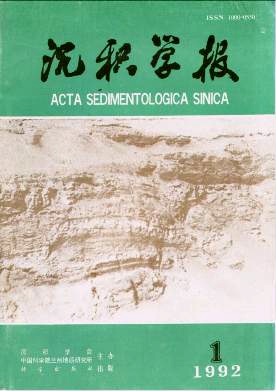The Composition and Hydrocarbon-generation Evolution of Organic Matter Associated with Carbonate Minerals
- Received Date: 1991-02-19
- Publish Date: 1992-03-10
Abstract: As the organic geochemical characteristics of marine carbonate rocks from Sinian to Triassic (Southernwest China) was studied, it was discovered that a vast amount of the extractable organic matter ( EOM) was present in carbonate cryptomerous minerals, which was wrapped up in them during early diagenesis. The organic matter was obtained by stepwise extraction in conjunction with stepwise dissolution of the carbonate and subsequently silicate minerals. The amount of the bound bitumen comes up to 176.96~ 1438.68 ppm with the average of 721.95 ppm in three limestone samples at lower maturity (R°= 0. -1.0%, over 22 percent of the total amount of the EOM. The bitumen fractions associated with minerals have the low mature features which are indicated by high content of colloid and asphaltene, obvious carbon number predominance of n-alkanes, the high concentration of unstable isomers of steranes (aa and R types), a large number of multicyclic and isomeric alkanes (e.g. C21-C40 isoprenoids, C19-C39 lng chain alkyl tricyclic terpanes, hopanes, benzohopanes, aromatic steranes etc.). When the evolution of organic matter reaches early stage of over-maturity (Rc (calculated vitrinite reflectance≈2.0%, Tmax ≈485℃, the bound bitumen fractions began to release from carbonate minerals and generate liquid hydrocarbons namely "high temperature oil". The generation tends to its end as Rc exceeds 3.0%. The processes have been verified by a thermal experiment in laboratory. Therefore, contributions to the formation of oil and in carbonate are made not only by kerogen but also by associated organic matter. Owing to the main components of carbonate organic matter are protein. carbohydrate and lipid, and the kerogen content in carbonate rocks is lower (about 50 percent of the total amount of organic matter) the mudstone, it appears that the soluble organic matter (free and bound) in carbonate produces directly hydrocarbons is more important.
| Citation: | Zhang Shuichang, Tong Zhengyan. The Composition and Hydrocarbon-generation Evolution of Organic Matter Associated with Carbonate Minerals[J]. Acta Sedimentologica Sinica, 1992, 10(1): 76-82. |






 DownLoad:
DownLoad: